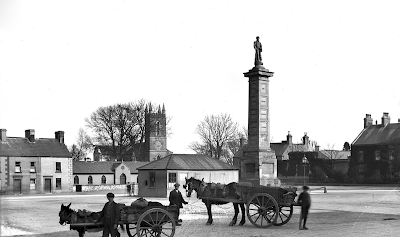It stands at the head of the westerly projection of Strangford Lough, and at the intersection of the Belfast and Killyleagh road with the Donaghadee and Ballynahinch road, 3 miles south-south-west of Newtownards, and 7 east-south-east of Belfast.
A Cistercian abbey formerly stood at the town, and appears to have been founded in the 12th century, some say by the Whites [Cistercians] who settled in Down under Sir John de Courcy, others say by nobody knows whom.
The weaving of linen gives employment to a large number of the inhabitants; and the work of two distilleries and a large bleaching-green gives employment to others.
It is tolerably well built, and consists principally of a square and three streets.
The tide from Strangford Lough flows to within half a mile of the town, and at a trifling expense might be made very beneficial to it.
Great advantages would also result from the erection of a pier near Comber water foot; vessels of 200 tons might then come in with every tide.
Coal is at present brought up in small lighters, but the principal fuel is peat; there is a very extensive bog, called Moneyreagh, or the Royal Bog, from which great quantities are sent to Belfast and other places.
 |
| The Square, Comber (Image: William Alfred Green) |
A Cistercian abbey formerly stood at the town, and appears to have been founded in the 12th century, some say by the Whites [Cistercians] who settled in Down under Sir John de Courcy, others say by nobody knows whom.
Archdall, of course, has no difficulty in naming the founder, or even summarily ascribing the original foundation to that pretended originator of countless monasteries, St Patrick.
He says,
St Patrick founded an abbey here, of which we have no further account, but Brian Catha Duin, from whom the O'Neills of Claneboye descended, built one to the honour of the Virgin Mary, and supplied it with monks of the Cistercian Order from the abbey of Alba Landa [Whitland], in Carmarthenshire. The founder fell by the sword of John de Courcy about 1201. John O'Mullegan was the last abbot, and he voluntarily resigned in 1543.
The abbey, with its possessions, was granted by JAMES I to Sir James Hamilton, Lord Claneboye, at the rent of £3 2s 2d [about £1,000 in 2020]; it passed by assignment to the Viscount Montgomery, of the Ards; and its stones were reconstructed into a castle called MOUNT ALEXANDER, which now in its turn is a heap of ruins.
The parish church, which occupies the site of the abbey, is in the later style of English architecture, and contains some neat marble monuments, particularly those to the memory of the Rev Robert Mortimer, Captain Chetwynd, Lieutenant Unite, and Ensign Spark, of the York Fencible Infantry, who fell in the battle of Saintfield during the disturbances of 1798.
 |
| Main Street, Comber (W A Green/NMNI) |
The weaving of linen gives employment to a large number of the inhabitants; and the work of two distilleries and a large bleaching-green gives employment to others.
The trade of the town would probably be much improved by the erection of a pier at the Water-foot.
Fairs are held on the first Thursday of January, and on April 5, June 28, and October 19.
Messrs Andrews and Sons have an extensive bleach-green here, where 20,000 pieces of linen are finished annually, principally for the London market; they have also large flour-mills and corn stores.
There are two distilleries: one of them, which is the property of Messrs Millar & Co, is among the oldest in the north of Ireland, having been erected in 1765.
There are several gentlemen's seats, the principal of which are Ballybeen, the residence of J Birch; Ballyalloly, at present unoccupied; KILLYNETHER HOUSE; and MAXWELL COURT.
In 1838, the public conveyances were a car to Killyleagh, two caravans to Belfast, and a mail-car in transit between Belfast and Downpatrick.
Area of the town, 95 acres.
First published in April, 2021.



3 comments :
'There are several gentlemen's seats, the principal of which are Ballybeen, the residence of J Birch' - I believe the original Ballybeen House was destroyed by fire in the early 1900s. Any chance you have any photos of the house as I have struggled to find one.
Hello Anon, J A K Dean's "The Plight of the Big House in Northern Ireland" features an article about Ballybeen House. It burned down in 1903 and was gone by 1905. This was a Georgian house of ca 1790. There is a "restorative drawing" of the house in the book. Tim.
Tim thanks so much!
Post a Comment